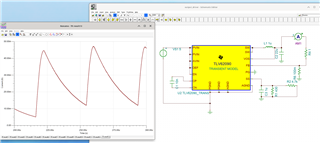Hi,
I have three TLV62090's operating as current regulators. I adjust the current by tracking a voltage at the SS pin. The minimum current is set by R1 and R2 (R2 actually goes through a PWM driver, and so here duty=0).
The models both in Tina and in LTSpice both indicate the lowest current regulation of 30mA, which is the requirement.
In real-life the lowest current through the load is measured as 275mA by ADC with 256x oversampling, or 239mA by Bryen BM896 multimeter (about as good as it gets). Either way it's a long way off the required 30mA.
Any clues much appreciated!
Andrew
output_driver.tsc.zip
-
Ask a related question
What is a related question?A related question is a question created from another question. When the related question is created, it will be automatically linked to the original question.

